A Detailed Look at Bias Sources in Academic Psychology Studies
VerifiedAdded on 2023/06/10
|11
|3386
|237
Essay
AI Summary
This essay delves into various sources of bias prevalent in academic psychology, drawing upon the insights of Daniel Kahneman and Tversky, who introduced the concept of psychological bias. It identifies three key biases: confirmation bias, anchoring bias, and overconfidence bias, detailing their impact on research and decision-making. Confirmation bias involves seeking information that confirms existing beliefs, while anchoring bias highlights the reliance on initial data when making decisions. Overconfidence bias refers to an inflated belief in one's abilities. The essay provides practical strategies to overcome each bias, such as considering diverse perspectives, taking time for reflection, and acknowledging limitations. Ultimately, the paper emphasizes the importance of recognizing and mitigating these biases to enhance the quality and objectivity of psychological research. Desklib offers further study tools and solved assignments on this topic.
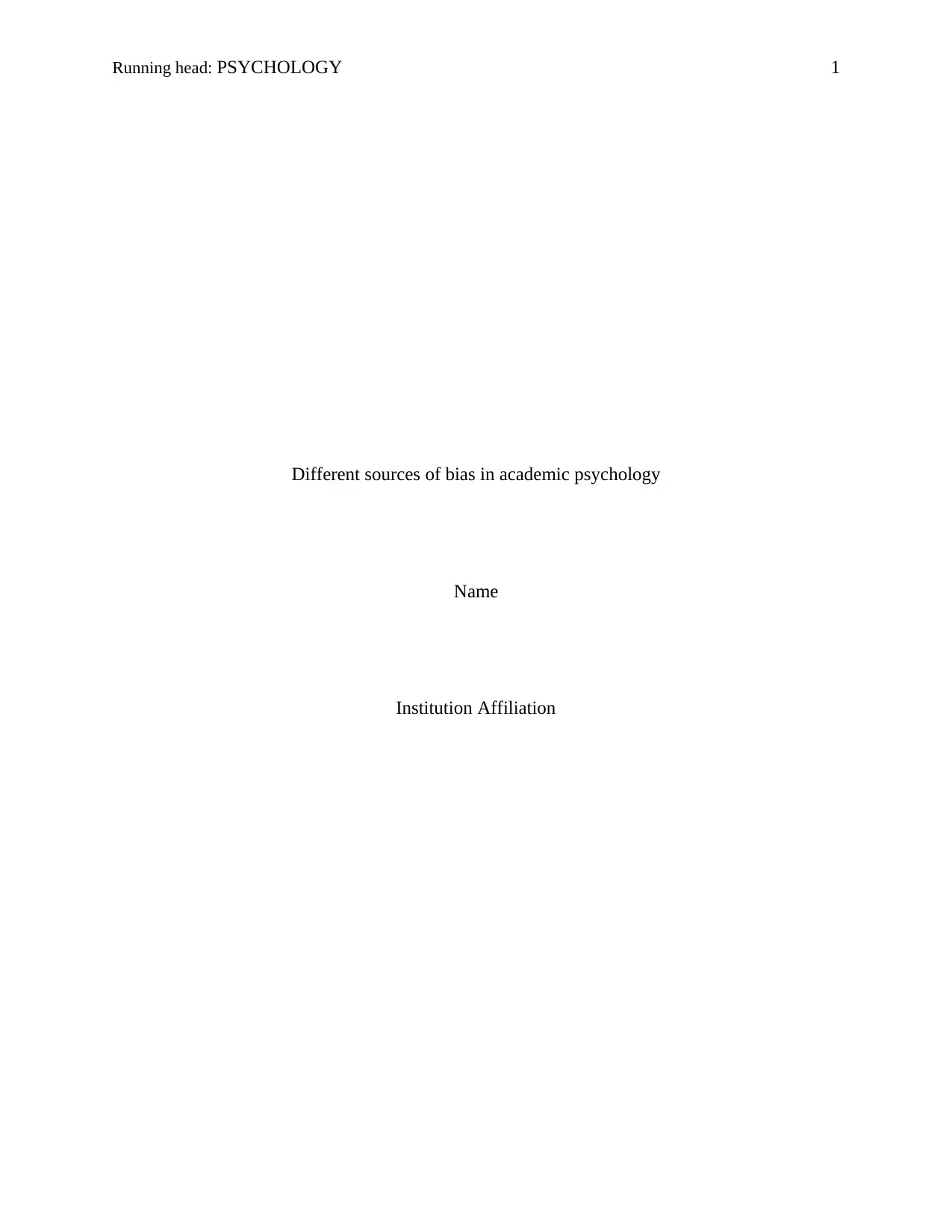
Running head: PSYCHOLOGY 1
Different sources of bias in academic psychology
Name
Institution Affiliation
Different sources of bias in academic psychology
Name
Institution Affiliation
Paraphrase This Document
Need a fresh take? Get an instant paraphrase of this document with our AI Paraphraser
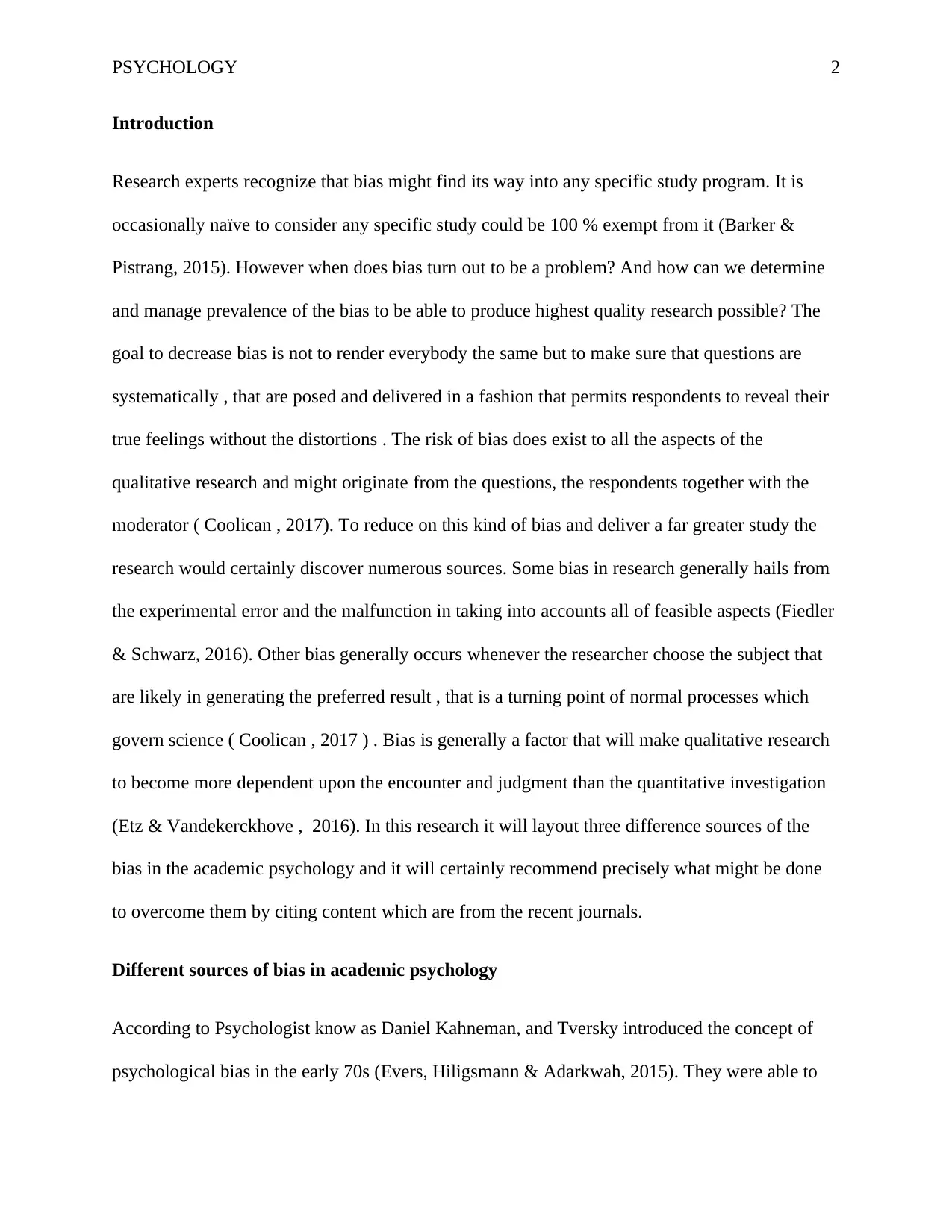
PSYCHOLOGY 2
Introduction
Research experts recognize that bias might find its way into any specific study program. It is
occasionally naïve to consider any specific study could be 100 % exempt from it (Barker &
Pistrang, 2015). However when does bias turn out to be a problem? And how can we determine
and manage prevalence of the bias to be able to produce highest quality research possible? The
goal to decrease bias is not to render everybody the same but to make sure that questions are
systematically , that are posed and delivered in a fashion that permits respondents to reveal their
true feelings without the distortions . The risk of bias does exist to all the aspects of the
qualitative research and might originate from the questions, the respondents together with the
moderator ( Coolican , 2017). To reduce on this kind of bias and deliver a far greater study the
research would certainly discover numerous sources. Some bias in research generally hails from
the experimental error and the malfunction in taking into accounts all of feasible aspects (Fiedler
& Schwarz, 2016). Other bias generally occurs whenever the researcher choose the subject that
are likely in generating the preferred result , that is a turning point of normal processes which
govern science ( Coolican , 2017 ) . Bias is generally a factor that will make qualitative research
to become more dependent upon the encounter and judgment than the quantitative investigation
(Etz & Vandekerckhove , 2016). In this research it will layout three difference sources of the
bias in the academic psychology and it will certainly recommend precisely what might be done
to overcome them by citing content which are from the recent journals.
Different sources of bias in academic psychology
According to Psychologist know as Daniel Kahneman, and Tversky introduced the concept of
psychological bias in the early 70s (Evers, Hiligsmann & Adarkwah, 2015). They were able to
Introduction
Research experts recognize that bias might find its way into any specific study program. It is
occasionally naïve to consider any specific study could be 100 % exempt from it (Barker &
Pistrang, 2015). However when does bias turn out to be a problem? And how can we determine
and manage prevalence of the bias to be able to produce highest quality research possible? The
goal to decrease bias is not to render everybody the same but to make sure that questions are
systematically , that are posed and delivered in a fashion that permits respondents to reveal their
true feelings without the distortions . The risk of bias does exist to all the aspects of the
qualitative research and might originate from the questions, the respondents together with the
moderator ( Coolican , 2017). To reduce on this kind of bias and deliver a far greater study the
research would certainly discover numerous sources. Some bias in research generally hails from
the experimental error and the malfunction in taking into accounts all of feasible aspects (Fiedler
& Schwarz, 2016). Other bias generally occurs whenever the researcher choose the subject that
are likely in generating the preferred result , that is a turning point of normal processes which
govern science ( Coolican , 2017 ) . Bias is generally a factor that will make qualitative research
to become more dependent upon the encounter and judgment than the quantitative investigation
(Etz & Vandekerckhove , 2016). In this research it will layout three difference sources of the
bias in the academic psychology and it will certainly recommend precisely what might be done
to overcome them by citing content which are from the recent journals.
Different sources of bias in academic psychology
According to Psychologist know as Daniel Kahneman, and Tversky introduced the concept of
psychological bias in the early 70s (Evers, Hiligsmann & Adarkwah, 2015). They were able to
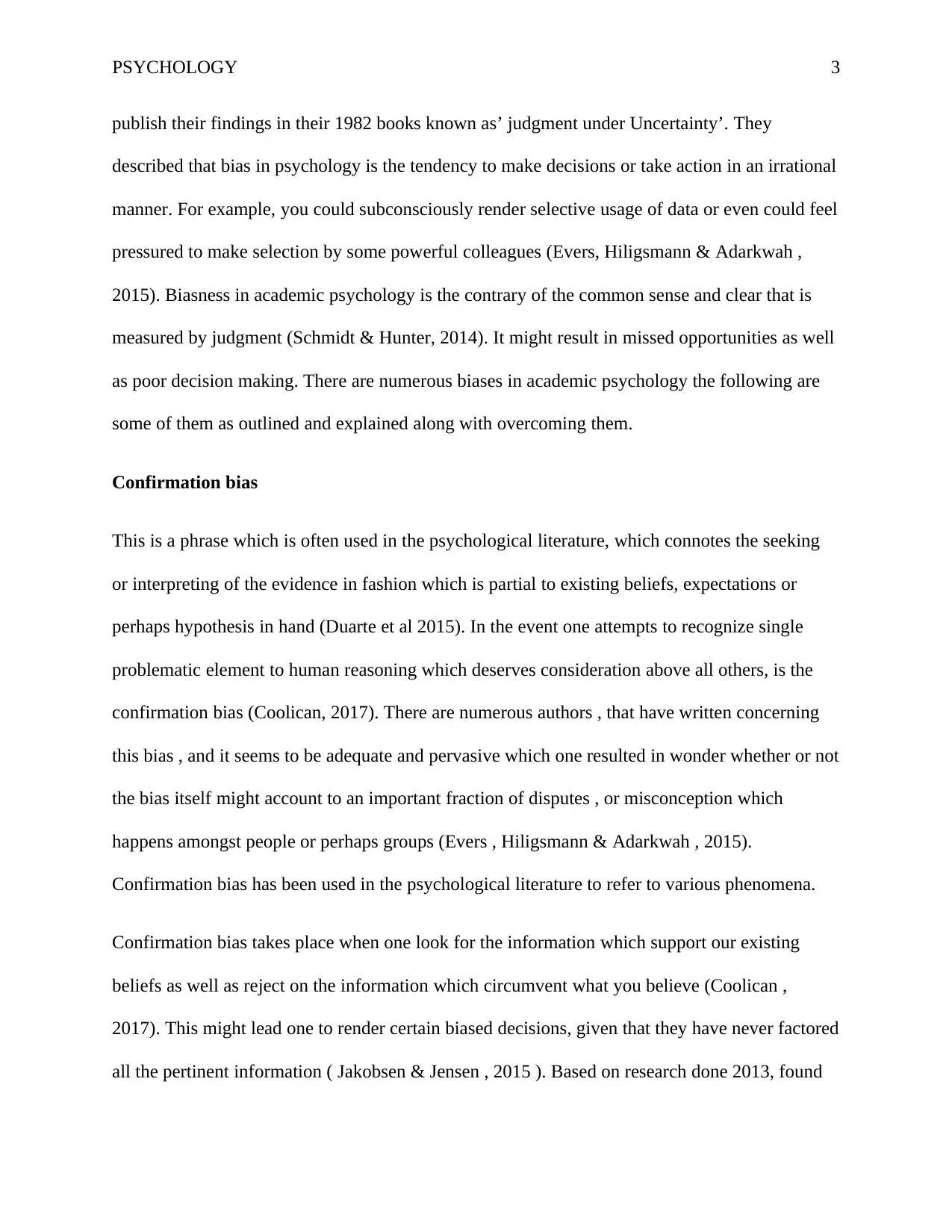
PSYCHOLOGY 3
publish their findings in their 1982 books known as’ judgment under Uncertainty’. They
described that bias in psychology is the tendency to make decisions or take action in an irrational
manner. For example, you could subconsciously render selective usage of data or even could feel
pressured to make selection by some powerful colleagues (Evers, Hiligsmann & Adarkwah ,
2015). Biasness in academic psychology is the contrary of the common sense and clear that is
measured by judgment (Schmidt & Hunter, 2014). It might result in missed opportunities as well
as poor decision making. There are numerous biases in academic psychology the following are
some of them as outlined and explained along with overcoming them.
Confirmation bias
This is a phrase which is often used in the psychological literature, which connotes the seeking
or interpreting of the evidence in fashion which is partial to existing beliefs, expectations or
perhaps hypothesis in hand (Duarte et al 2015). In the event one attempts to recognize single
problematic element to human reasoning which deserves consideration above all others, is the
confirmation bias (Coolican, 2017). There are numerous authors , that have written concerning
this bias , and it seems to be adequate and pervasive which one resulted in wonder whether or not
the bias itself might account to an important fraction of disputes , or misconception which
happens amongst people or perhaps groups (Evers , Hiligsmann & Adarkwah , 2015).
Confirmation bias has been used in the psychological literature to refer to various phenomena.
Confirmation bias takes place when one look for the information which support our existing
beliefs as well as reject on the information which circumvent what you believe (Coolican ,
2017). This might lead one to render certain biased decisions, given that they have never factored
all the pertinent information ( Jakobsen & Jensen , 2015 ). Based on research done 2013, found
publish their findings in their 1982 books known as’ judgment under Uncertainty’. They
described that bias in psychology is the tendency to make decisions or take action in an irrational
manner. For example, you could subconsciously render selective usage of data or even could feel
pressured to make selection by some powerful colleagues (Evers, Hiligsmann & Adarkwah ,
2015). Biasness in academic psychology is the contrary of the common sense and clear that is
measured by judgment (Schmidt & Hunter, 2014). It might result in missed opportunities as well
as poor decision making. There are numerous biases in academic psychology the following are
some of them as outlined and explained along with overcoming them.
Confirmation bias
This is a phrase which is often used in the psychological literature, which connotes the seeking
or interpreting of the evidence in fashion which is partial to existing beliefs, expectations or
perhaps hypothesis in hand (Duarte et al 2015). In the event one attempts to recognize single
problematic element to human reasoning which deserves consideration above all others, is the
confirmation bias (Coolican, 2017). There are numerous authors , that have written concerning
this bias , and it seems to be adequate and pervasive which one resulted in wonder whether or not
the bias itself might account to an important fraction of disputes , or misconception which
happens amongst people or perhaps groups (Evers , Hiligsmann & Adarkwah , 2015).
Confirmation bias has been used in the psychological literature to refer to various phenomena.
Confirmation bias takes place when one look for the information which support our existing
beliefs as well as reject on the information which circumvent what you believe (Coolican ,
2017). This might lead one to render certain biased decisions, given that they have never factored
all the pertinent information ( Jakobsen & Jensen , 2015 ). Based on research done 2013, found
⊘ This is a preview!⊘
Do you want full access?
Subscribe today to unlock all pages.

Trusted by 1+ million students worldwide
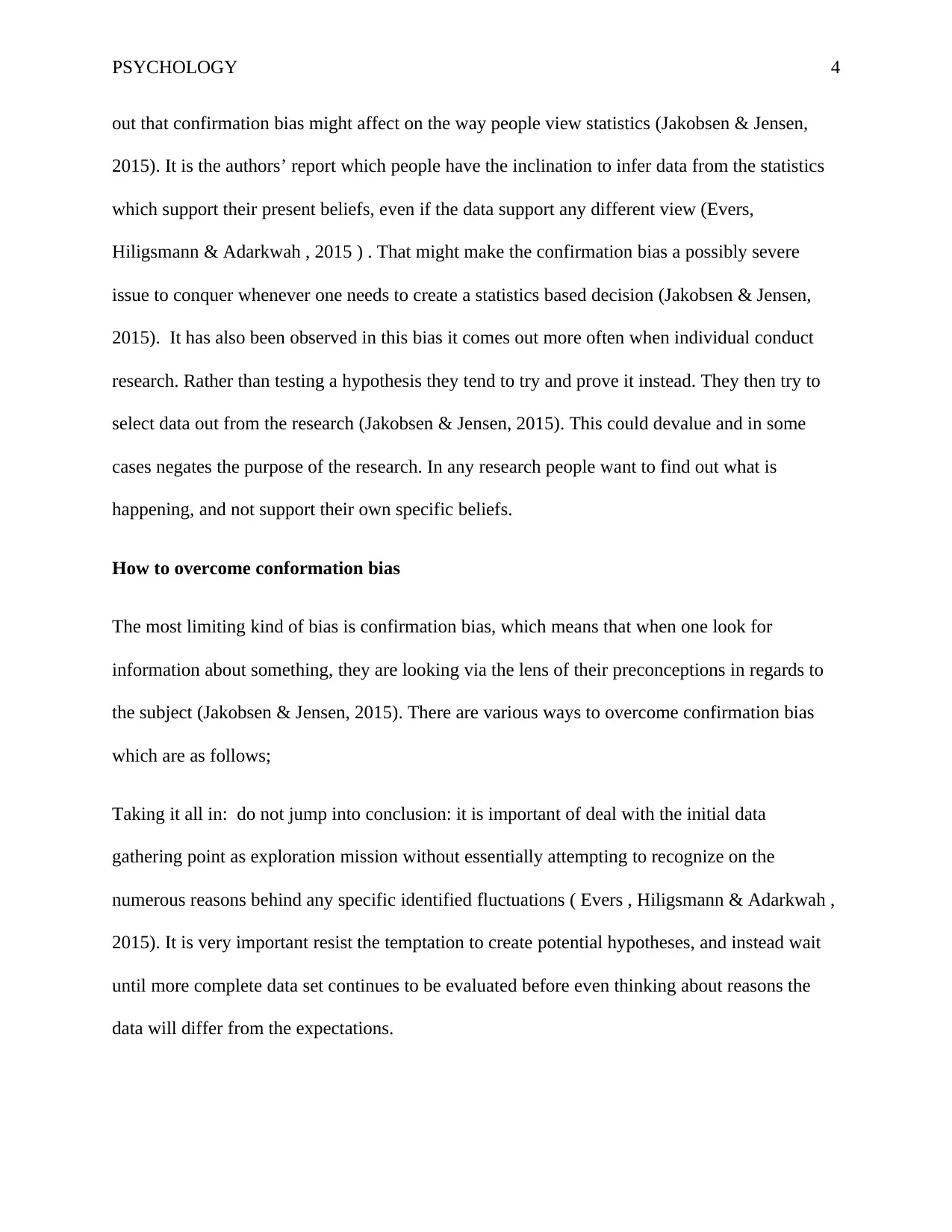
PSYCHOLOGY 4
out that confirmation bias might affect on the way people view statistics (Jakobsen & Jensen,
2015). It is the authors’ report which people have the inclination to infer data from the statistics
which support their present beliefs, even if the data support any different view (Evers,
Hiligsmann & Adarkwah , 2015 ) . That might make the confirmation bias a possibly severe
issue to conquer whenever one needs to create a statistics based decision (Jakobsen & Jensen,
2015). It has also been observed in this bias it comes out more often when individual conduct
research. Rather than testing a hypothesis they tend to try and prove it instead. They then try to
select data out from the research (Jakobsen & Jensen, 2015). This could devalue and in some
cases negates the purpose of the research. In any research people want to find out what is
happening, and not support their own specific beliefs.
How to overcome conformation bias
The most limiting kind of bias is confirmation bias, which means that when one look for
information about something, they are looking via the lens of their preconceptions in regards to
the subject (Jakobsen & Jensen, 2015). There are various ways to overcome confirmation bias
which are as follows;
Taking it all in: do not jump into conclusion: it is important of deal with the initial data
gathering point as exploration mission without essentially attempting to recognize on the
numerous reasons behind any specific identified fluctuations ( Evers , Hiligsmann & Adarkwah ,
2015). It is very important resist the temptation to create potential hypotheses, and instead wait
until more complete data set continues to be evaluated before even thinking about reasons the
data will differ from the expectations.
out that confirmation bias might affect on the way people view statistics (Jakobsen & Jensen,
2015). It is the authors’ report which people have the inclination to infer data from the statistics
which support their present beliefs, even if the data support any different view (Evers,
Hiligsmann & Adarkwah , 2015 ) . That might make the confirmation bias a possibly severe
issue to conquer whenever one needs to create a statistics based decision (Jakobsen & Jensen,
2015). It has also been observed in this bias it comes out more often when individual conduct
research. Rather than testing a hypothesis they tend to try and prove it instead. They then try to
select data out from the research (Jakobsen & Jensen, 2015). This could devalue and in some
cases negates the purpose of the research. In any research people want to find out what is
happening, and not support their own specific beliefs.
How to overcome conformation bias
The most limiting kind of bias is confirmation bias, which means that when one look for
information about something, they are looking via the lens of their preconceptions in regards to
the subject (Jakobsen & Jensen, 2015). There are various ways to overcome confirmation bias
which are as follows;
Taking it all in: do not jump into conclusion: it is important of deal with the initial data
gathering point as exploration mission without essentially attempting to recognize on the
numerous reasons behind any specific identified fluctuations ( Evers , Hiligsmann & Adarkwah ,
2015). It is very important resist the temptation to create potential hypotheses, and instead wait
until more complete data set continues to be evaluated before even thinking about reasons the
data will differ from the expectations.
Paraphrase This Document
Need a fresh take? Get an instant paraphrase of this document with our AI Paraphraser
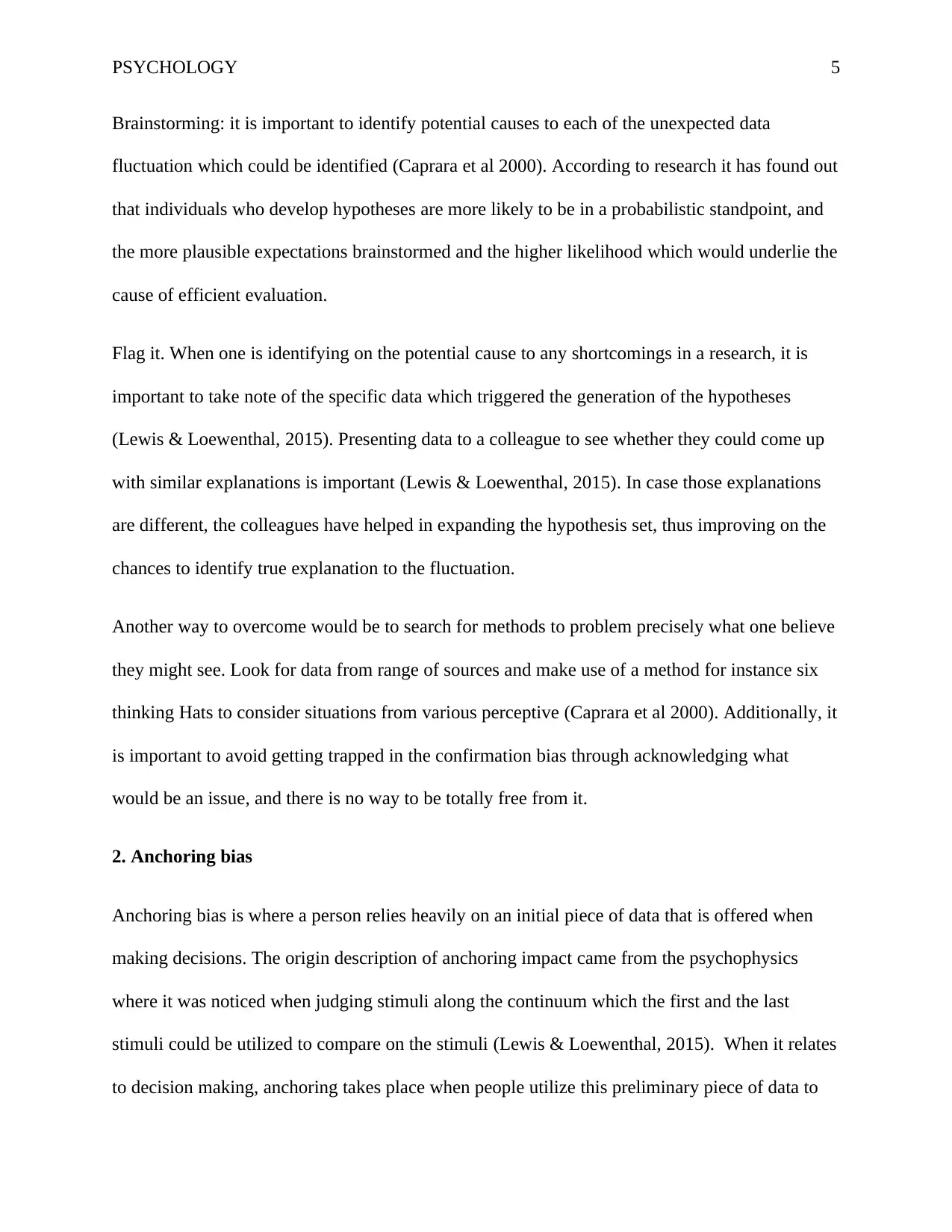
PSYCHOLOGY 5
Brainstorming: it is important to identify potential causes to each of the unexpected data
fluctuation which could be identified (Caprara et al 2000). According to research it has found out
that individuals who develop hypotheses are more likely to be in a probabilistic standpoint, and
the more plausible expectations brainstormed and the higher likelihood which would underlie the
cause of efficient evaluation.
Flag it. When one is identifying on the potential cause to any shortcomings in a research, it is
important to take note of the specific data which triggered the generation of the hypotheses
(Lewis & Loewenthal, 2015). Presenting data to a colleague to see whether they could come up
with similar explanations is important (Lewis & Loewenthal, 2015). In case those explanations
are different, the colleagues have helped in expanding the hypothesis set, thus improving on the
chances to identify true explanation to the fluctuation.
Another way to overcome would be to search for methods to problem precisely what one believe
they might see. Look for data from range of sources and make use of a method for instance six
thinking Hats to consider situations from various perceptive (Caprara et al 2000). Additionally, it
is important to avoid getting trapped in the confirmation bias through acknowledging what
would be an issue, and there is no way to be totally free from it.
2. Anchoring bias
Anchoring bias is where a person relies heavily on an initial piece of data that is offered when
making decisions. The origin description of anchoring impact came from the psychophysics
where it was noticed when judging stimuli along the continuum which the first and the last
stimuli could be utilized to compare on the stimuli (Lewis & Loewenthal, 2015). When it relates
to decision making, anchoring takes place when people utilize this preliminary piece of data to
Brainstorming: it is important to identify potential causes to each of the unexpected data
fluctuation which could be identified (Caprara et al 2000). According to research it has found out
that individuals who develop hypotheses are more likely to be in a probabilistic standpoint, and
the more plausible expectations brainstormed and the higher likelihood which would underlie the
cause of efficient evaluation.
Flag it. When one is identifying on the potential cause to any shortcomings in a research, it is
important to take note of the specific data which triggered the generation of the hypotheses
(Lewis & Loewenthal, 2015). Presenting data to a colleague to see whether they could come up
with similar explanations is important (Lewis & Loewenthal, 2015). In case those explanations
are different, the colleagues have helped in expanding the hypothesis set, thus improving on the
chances to identify true explanation to the fluctuation.
Another way to overcome would be to search for methods to problem precisely what one believe
they might see. Look for data from range of sources and make use of a method for instance six
thinking Hats to consider situations from various perceptive (Caprara et al 2000). Additionally, it
is important to avoid getting trapped in the confirmation bias through acknowledging what
would be an issue, and there is no way to be totally free from it.
2. Anchoring bias
Anchoring bias is where a person relies heavily on an initial piece of data that is offered when
making decisions. The origin description of anchoring impact came from the psychophysics
where it was noticed when judging stimuli along the continuum which the first and the last
stimuli could be utilized to compare on the stimuli (Lewis & Loewenthal, 2015). When it relates
to decision making, anchoring takes place when people utilize this preliminary piece of data to
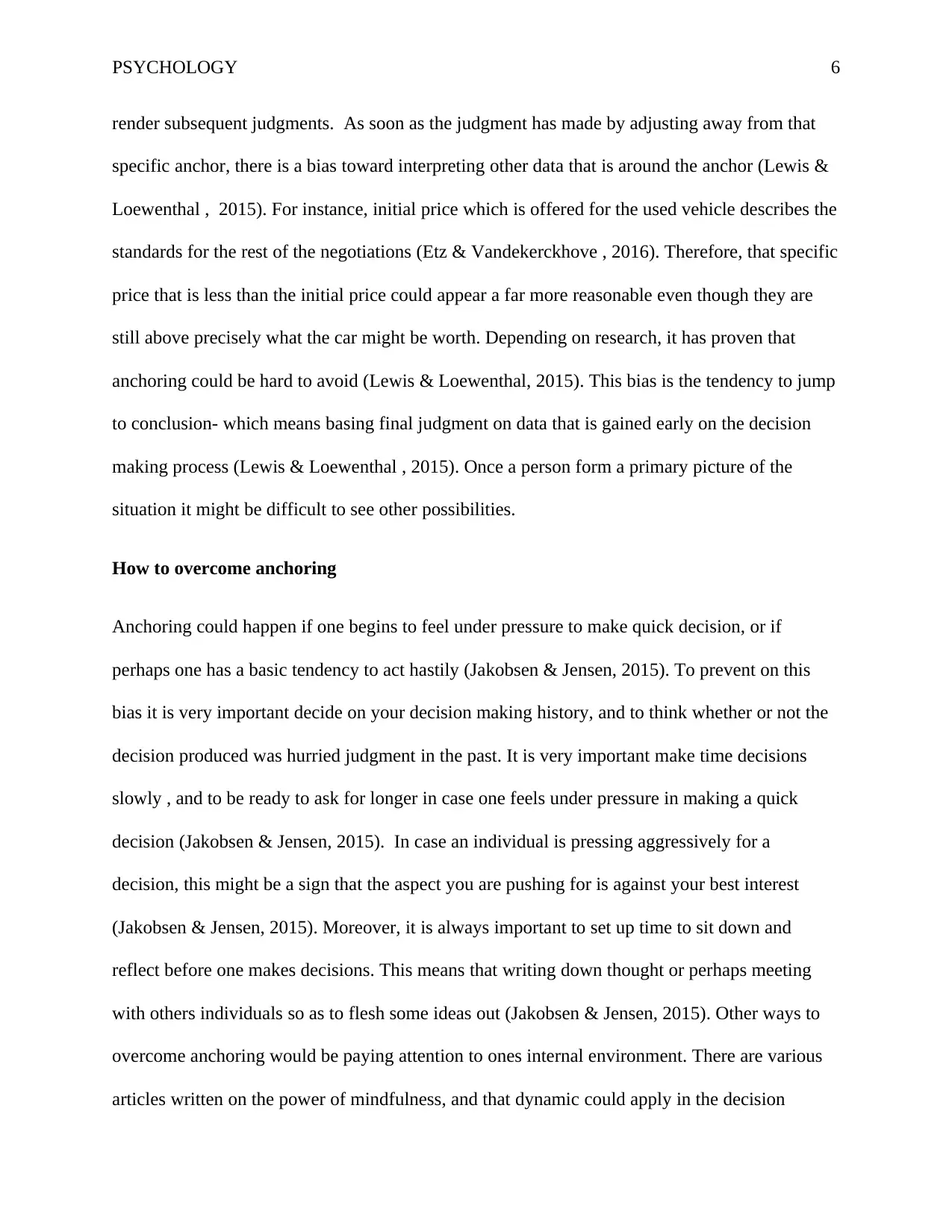
PSYCHOLOGY 6
render subsequent judgments. As soon as the judgment has made by adjusting away from that
specific anchor, there is a bias toward interpreting other data that is around the anchor (Lewis &
Loewenthal , 2015). For instance, initial price which is offered for the used vehicle describes the
standards for the rest of the negotiations (Etz & Vandekerckhove , 2016). Therefore, that specific
price that is less than the initial price could appear a far more reasonable even though they are
still above precisely what the car might be worth. Depending on research, it has proven that
anchoring could be hard to avoid (Lewis & Loewenthal, 2015). This bias is the tendency to jump
to conclusion- which means basing final judgment on data that is gained early on the decision
making process (Lewis & Loewenthal , 2015). Once a person form a primary picture of the
situation it might be difficult to see other possibilities.
How to overcome anchoring
Anchoring could happen if one begins to feel under pressure to make quick decision, or if
perhaps one has a basic tendency to act hastily (Jakobsen & Jensen, 2015). To prevent on this
bias it is very important decide on your decision making history, and to think whether or not the
decision produced was hurried judgment in the past. It is very important make time decisions
slowly , and to be ready to ask for longer in case one feels under pressure in making a quick
decision (Jakobsen & Jensen, 2015). In case an individual is pressing aggressively for a
decision, this might be a sign that the aspect you are pushing for is against your best interest
(Jakobsen & Jensen, 2015). Moreover, it is always important to set up time to sit down and
reflect before one makes decisions. This means that writing down thought or perhaps meeting
with others individuals so as to flesh some ideas out (Jakobsen & Jensen, 2015). Other ways to
overcome anchoring would be paying attention to ones internal environment. There are various
articles written on the power of mindfulness, and that dynamic could apply in the decision
render subsequent judgments. As soon as the judgment has made by adjusting away from that
specific anchor, there is a bias toward interpreting other data that is around the anchor (Lewis &
Loewenthal , 2015). For instance, initial price which is offered for the used vehicle describes the
standards for the rest of the negotiations (Etz & Vandekerckhove , 2016). Therefore, that specific
price that is less than the initial price could appear a far more reasonable even though they are
still above precisely what the car might be worth. Depending on research, it has proven that
anchoring could be hard to avoid (Lewis & Loewenthal, 2015). This bias is the tendency to jump
to conclusion- which means basing final judgment on data that is gained early on the decision
making process (Lewis & Loewenthal , 2015). Once a person form a primary picture of the
situation it might be difficult to see other possibilities.
How to overcome anchoring
Anchoring could happen if one begins to feel under pressure to make quick decision, or if
perhaps one has a basic tendency to act hastily (Jakobsen & Jensen, 2015). To prevent on this
bias it is very important decide on your decision making history, and to think whether or not the
decision produced was hurried judgment in the past. It is very important make time decisions
slowly , and to be ready to ask for longer in case one feels under pressure in making a quick
decision (Jakobsen & Jensen, 2015). In case an individual is pressing aggressively for a
decision, this might be a sign that the aspect you are pushing for is against your best interest
(Jakobsen & Jensen, 2015). Moreover, it is always important to set up time to sit down and
reflect before one makes decisions. This means that writing down thought or perhaps meeting
with others individuals so as to flesh some ideas out (Jakobsen & Jensen, 2015). Other ways to
overcome anchoring would be paying attention to ones internal environment. There are various
articles written on the power of mindfulness, and that dynamic could apply in the decision
⊘ This is a preview!⊘
Do you want full access?
Subscribe today to unlock all pages.

Trusted by 1+ million students worldwide
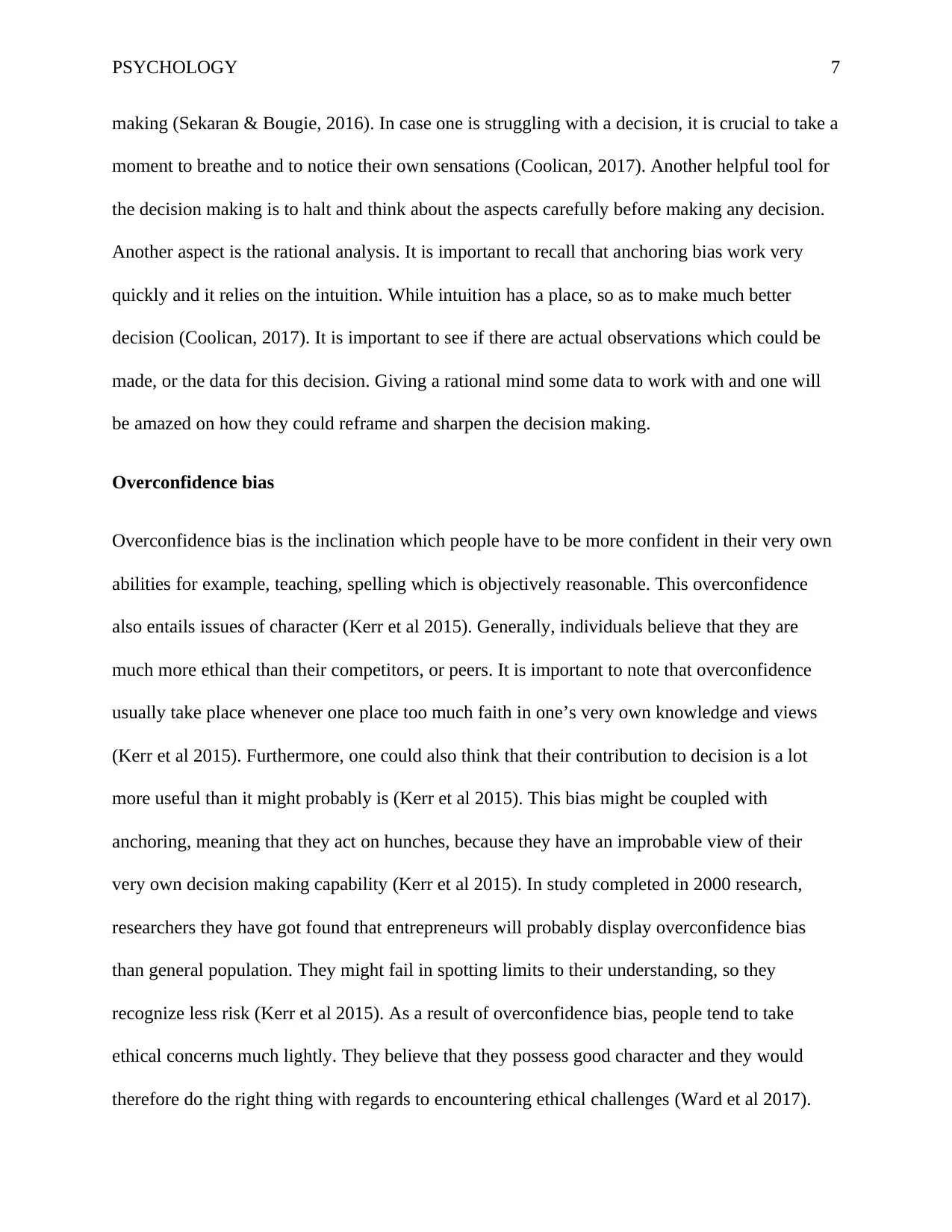
PSYCHOLOGY 7
making (Sekaran & Bougie, 2016). In case one is struggling with a decision, it is crucial to take a
moment to breathe and to notice their own sensations (Coolican, 2017). Another helpful tool for
the decision making is to halt and think about the aspects carefully before making any decision.
Another aspect is the rational analysis. It is important to recall that anchoring bias work very
quickly and it relies on the intuition. While intuition has a place, so as to make much better
decision (Coolican, 2017). It is important to see if there are actual observations which could be
made, or the data for this decision. Giving a rational mind some data to work with and one will
be amazed on how they could reframe and sharpen the decision making.
Overconfidence bias
Overconfidence bias is the inclination which people have to be more confident in their very own
abilities for example, teaching, spelling which is objectively reasonable. This overconfidence
also entails issues of character (Kerr et al 2015). Generally, individuals believe that they are
much more ethical than their competitors, or peers. It is important to note that overconfidence
usually take place whenever one place too much faith in one’s very own knowledge and views
(Kerr et al 2015). Furthermore, one could also think that their contribution to decision is a lot
more useful than it might probably is (Kerr et al 2015). This bias might be coupled with
anchoring, meaning that they act on hunches, because they have an improbable view of their
very own decision making capability (Kerr et al 2015). In study completed in 2000 research,
researchers they have got found that entrepreneurs will probably display overconfidence bias
than general population. They might fail in spotting limits to their understanding, so they
recognize less risk (Kerr et al 2015). As a result of overconfidence bias, people tend to take
ethical concerns much lightly. They believe that they possess good character and they would
therefore do the right thing with regards to encountering ethical challenges (Ward et al 2017).
making (Sekaran & Bougie, 2016). In case one is struggling with a decision, it is crucial to take a
moment to breathe and to notice their own sensations (Coolican, 2017). Another helpful tool for
the decision making is to halt and think about the aspects carefully before making any decision.
Another aspect is the rational analysis. It is important to recall that anchoring bias work very
quickly and it relies on the intuition. While intuition has a place, so as to make much better
decision (Coolican, 2017). It is important to see if there are actual observations which could be
made, or the data for this decision. Giving a rational mind some data to work with and one will
be amazed on how they could reframe and sharpen the decision making.
Overconfidence bias
Overconfidence bias is the inclination which people have to be more confident in their very own
abilities for example, teaching, spelling which is objectively reasonable. This overconfidence
also entails issues of character (Kerr et al 2015). Generally, individuals believe that they are
much more ethical than their competitors, or peers. It is important to note that overconfidence
usually take place whenever one place too much faith in one’s very own knowledge and views
(Kerr et al 2015). Furthermore, one could also think that their contribution to decision is a lot
more useful than it might probably is (Kerr et al 2015). This bias might be coupled with
anchoring, meaning that they act on hunches, because they have an improbable view of their
very own decision making capability (Kerr et al 2015). In study completed in 2000 research,
researchers they have got found that entrepreneurs will probably display overconfidence bias
than general population. They might fail in spotting limits to their understanding, so they
recognize less risk (Kerr et al 2015). As a result of overconfidence bias, people tend to take
ethical concerns much lightly. They believe that they possess good character and they would
therefore do the right thing with regards to encountering ethical challenges (Ward et al 2017).
Paraphrase This Document
Need a fresh take? Get an instant paraphrase of this document with our AI Paraphraser
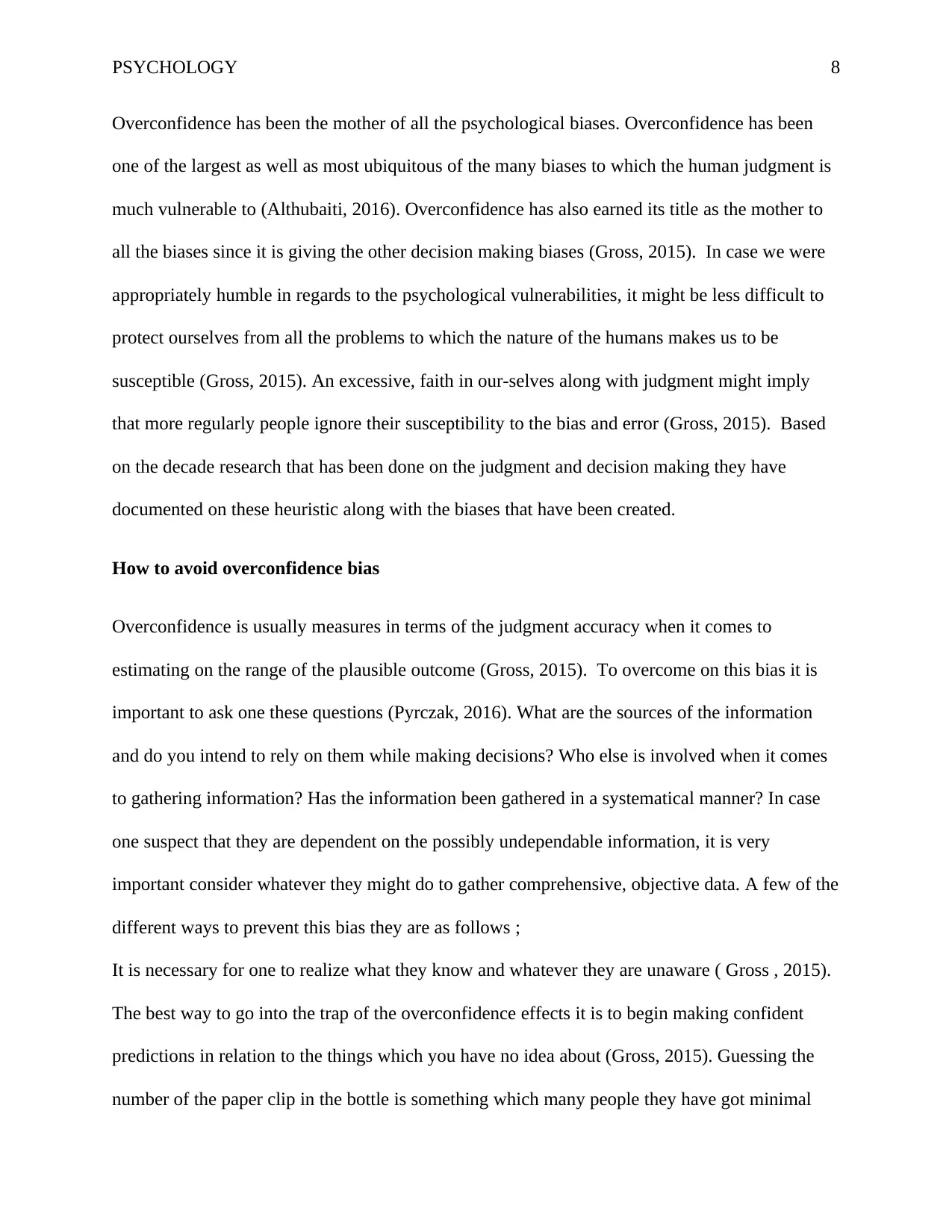
PSYCHOLOGY 8
Overconfidence has been the mother of all the psychological biases. Overconfidence has been
one of the largest as well as most ubiquitous of the many biases to which the human judgment is
much vulnerable to (Althubaiti, 2016). Overconfidence has also earned its title as the mother to
all the biases since it is giving the other decision making biases (Gross, 2015). In case we were
appropriately humble in regards to the psychological vulnerabilities, it might be less difficult to
protect ourselves from all the problems to which the nature of the humans makes us to be
susceptible (Gross, 2015). An excessive, faith in our-selves along with judgment might imply
that more regularly people ignore their susceptibility to the bias and error (Gross, 2015). Based
on the decade research that has been done on the judgment and decision making they have
documented on these heuristic along with the biases that have been created.
How to avoid overconfidence bias
Overconfidence is usually measures in terms of the judgment accuracy when it comes to
estimating on the range of the plausible outcome (Gross, 2015). To overcome on this bias it is
important to ask one these questions (Pyrczak, 2016). What are the sources of the information
and do you intend to rely on them while making decisions? Who else is involved when it comes
to gathering information? Has the information been gathered in a systematical manner? In case
one suspect that they are dependent on the possibly undependable information, it is very
important consider whatever they might do to gather comprehensive, objective data. A few of the
different ways to prevent this bias they are as follows ;
It is necessary for one to realize what they know and whatever they are unaware ( Gross , 2015).
The best way to go into the trap of the overconfidence effects it is to begin making confident
predictions in relation to the things which you have no idea about (Gross, 2015). Guessing the
number of the paper clip in the bottle is something which many people they have got minimal
Overconfidence has been the mother of all the psychological biases. Overconfidence has been
one of the largest as well as most ubiquitous of the many biases to which the human judgment is
much vulnerable to (Althubaiti, 2016). Overconfidence has also earned its title as the mother to
all the biases since it is giving the other decision making biases (Gross, 2015). In case we were
appropriately humble in regards to the psychological vulnerabilities, it might be less difficult to
protect ourselves from all the problems to which the nature of the humans makes us to be
susceptible (Gross, 2015). An excessive, faith in our-selves along with judgment might imply
that more regularly people ignore their susceptibility to the bias and error (Gross, 2015). Based
on the decade research that has been done on the judgment and decision making they have
documented on these heuristic along with the biases that have been created.
How to avoid overconfidence bias
Overconfidence is usually measures in terms of the judgment accuracy when it comes to
estimating on the range of the plausible outcome (Gross, 2015). To overcome on this bias it is
important to ask one these questions (Pyrczak, 2016). What are the sources of the information
and do you intend to rely on them while making decisions? Who else is involved when it comes
to gathering information? Has the information been gathered in a systematical manner? In case
one suspect that they are dependent on the possibly undependable information, it is very
important consider whatever they might do to gather comprehensive, objective data. A few of the
different ways to prevent this bias they are as follows ;
It is necessary for one to realize what they know and whatever they are unaware ( Gross , 2015).
The best way to go into the trap of the overconfidence effects it is to begin making confident
predictions in relation to the things which you have no idea about (Gross, 2015). Guessing the
number of the paper clip in the bottle is something which many people they have got minimal
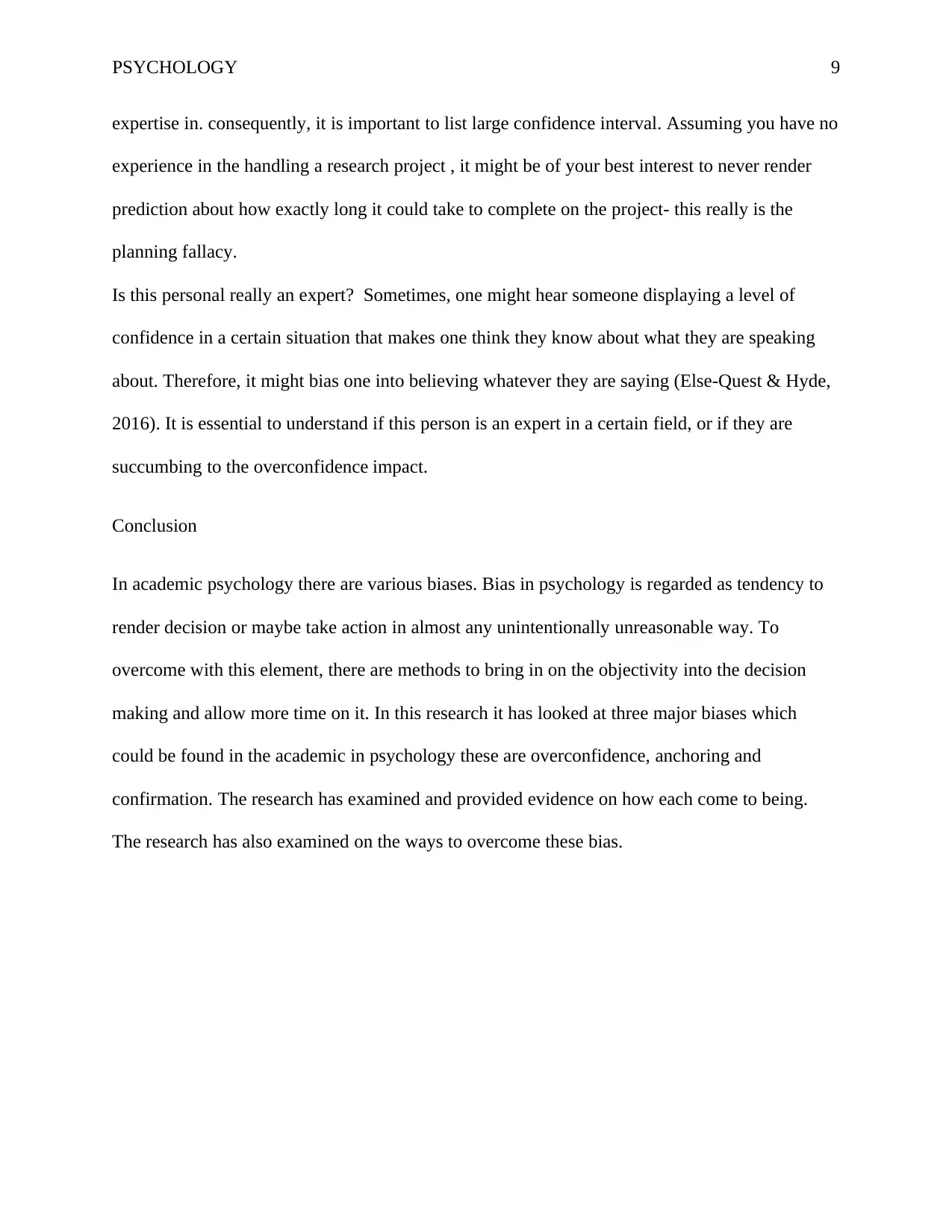
PSYCHOLOGY 9
expertise in. consequently, it is important to list large confidence interval. Assuming you have no
experience in the handling a research project , it might be of your best interest to never render
prediction about how exactly long it could take to complete on the project- this really is the
planning fallacy.
Is this personal really an expert? Sometimes, one might hear someone displaying a level of
confidence in a certain situation that makes one think they know about what they are speaking
about. Therefore, it might bias one into believing whatever they are saying (Else-Quest & Hyde,
2016). It is essential to understand if this person is an expert in a certain field, or if they are
succumbing to the overconfidence impact.
Conclusion
In academic psychology there are various biases. Bias in psychology is regarded as tendency to
render decision or maybe take action in almost any unintentionally unreasonable way. To
overcome with this element, there are methods to bring in on the objectivity into the decision
making and allow more time on it. In this research it has looked at three major biases which
could be found in the academic in psychology these are overconfidence, anchoring and
confirmation. The research has examined and provided evidence on how each come to being.
The research has also examined on the ways to overcome these bias.
expertise in. consequently, it is important to list large confidence interval. Assuming you have no
experience in the handling a research project , it might be of your best interest to never render
prediction about how exactly long it could take to complete on the project- this really is the
planning fallacy.
Is this personal really an expert? Sometimes, one might hear someone displaying a level of
confidence in a certain situation that makes one think they know about what they are speaking
about. Therefore, it might bias one into believing whatever they are saying (Else-Quest & Hyde,
2016). It is essential to understand if this person is an expert in a certain field, or if they are
succumbing to the overconfidence impact.
Conclusion
In academic psychology there are various biases. Bias in psychology is regarded as tendency to
render decision or maybe take action in almost any unintentionally unreasonable way. To
overcome with this element, there are methods to bring in on the objectivity into the decision
making and allow more time on it. In this research it has looked at three major biases which
could be found in the academic in psychology these are overconfidence, anchoring and
confirmation. The research has examined and provided evidence on how each come to being.
The research has also examined on the ways to overcome these bias.
⊘ This is a preview!⊘
Do you want full access?
Subscribe today to unlock all pages.

Trusted by 1+ million students worldwide
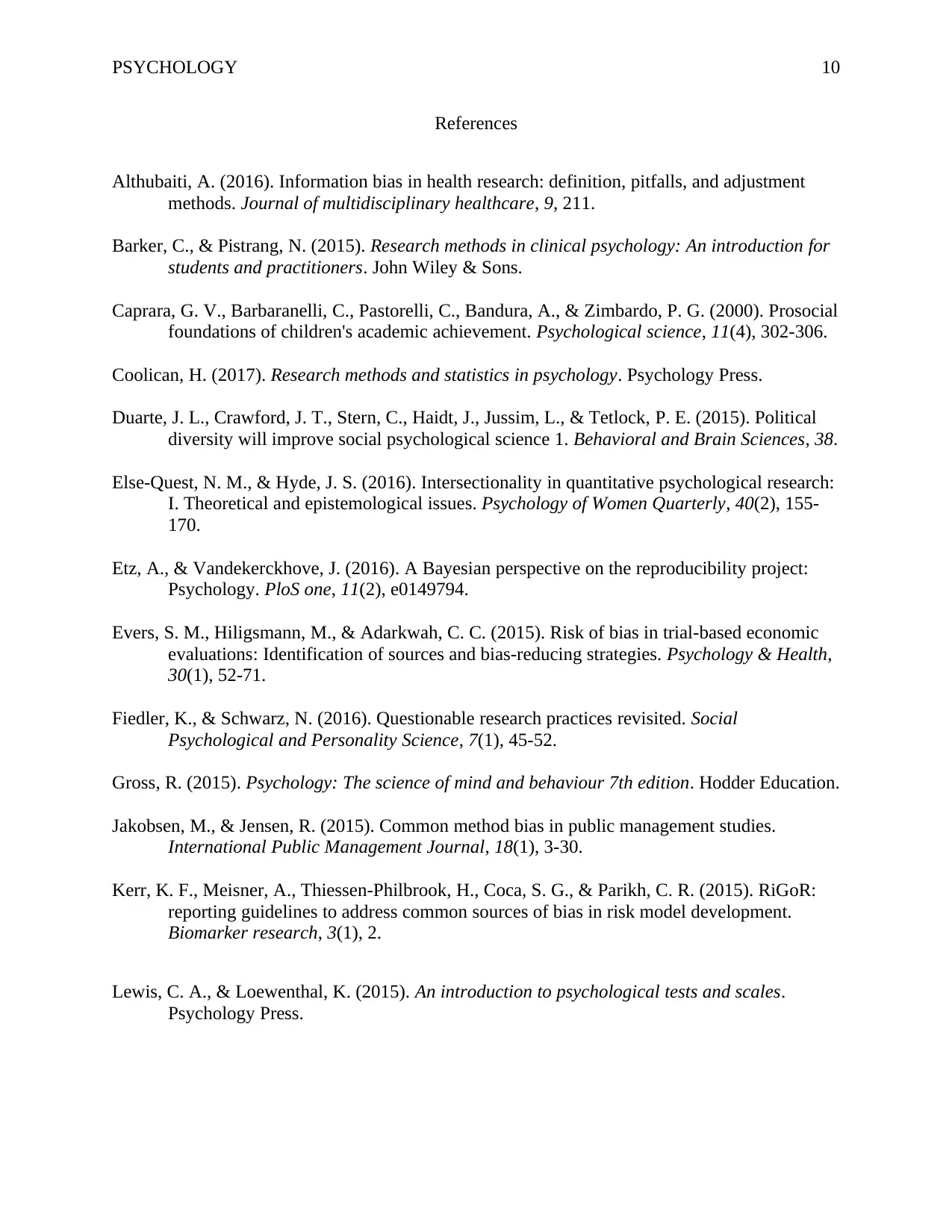
PSYCHOLOGY 10
References
Althubaiti, A. (2016). Information bias in health research: definition, pitfalls, and adjustment
methods. Journal of multidisciplinary healthcare, 9, 211.
Barker, C., & Pistrang, N. (2015). Research methods in clinical psychology: An introduction for
students and practitioners. John Wiley & Sons.
Caprara, G. V., Barbaranelli, C., Pastorelli, C., Bandura, A., & Zimbardo, P. G. (2000). Prosocial
foundations of children's academic achievement. Psychological science, 11(4), 302-306.
Coolican, H. (2017). Research methods and statistics in psychology. Psychology Press.
Duarte, J. L., Crawford, J. T., Stern, C., Haidt, J., Jussim, L., & Tetlock, P. E. (2015). Political
diversity will improve social psychological science 1. Behavioral and Brain Sciences, 38.
Else-Quest, N. M., & Hyde, J. S. (2016). Intersectionality in quantitative psychological research:
I. Theoretical and epistemological issues. Psychology of Women Quarterly, 40(2), 155-
170.
Etz, A., & Vandekerckhove, J. (2016). A Bayesian perspective on the reproducibility project:
Psychology. PloS one, 11(2), e0149794.
Evers, S. M., Hiligsmann, M., & Adarkwah, C. C. (2015). Risk of bias in trial-based economic
evaluations: Identification of sources and bias-reducing strategies. Psychology & Health,
30(1), 52-71.
Fiedler, K., & Schwarz, N. (2016). Questionable research practices revisited. Social
Psychological and Personality Science, 7(1), 45-52.
Gross, R. (2015). Psychology: The science of mind and behaviour 7th edition. Hodder Education.
Jakobsen, M., & Jensen, R. (2015). Common method bias in public management studies.
International Public Management Journal, 18(1), 3-30.
Kerr, K. F., Meisner, A., Thiessen-Philbrook, H., Coca, S. G., & Parikh, C. R. (2015). RiGoR:
reporting guidelines to address common sources of bias in risk model development.
Biomarker research, 3(1), 2.
Lewis, C. A., & Loewenthal, K. (2015). An introduction to psychological tests and scales.
Psychology Press.
References
Althubaiti, A. (2016). Information bias in health research: definition, pitfalls, and adjustment
methods. Journal of multidisciplinary healthcare, 9, 211.
Barker, C., & Pistrang, N. (2015). Research methods in clinical psychology: An introduction for
students and practitioners. John Wiley & Sons.
Caprara, G. V., Barbaranelli, C., Pastorelli, C., Bandura, A., & Zimbardo, P. G. (2000). Prosocial
foundations of children's academic achievement. Psychological science, 11(4), 302-306.
Coolican, H. (2017). Research methods and statistics in psychology. Psychology Press.
Duarte, J. L., Crawford, J. T., Stern, C., Haidt, J., Jussim, L., & Tetlock, P. E. (2015). Political
diversity will improve social psychological science 1. Behavioral and Brain Sciences, 38.
Else-Quest, N. M., & Hyde, J. S. (2016). Intersectionality in quantitative psychological research:
I. Theoretical and epistemological issues. Psychology of Women Quarterly, 40(2), 155-
170.
Etz, A., & Vandekerckhove, J. (2016). A Bayesian perspective on the reproducibility project:
Psychology. PloS one, 11(2), e0149794.
Evers, S. M., Hiligsmann, M., & Adarkwah, C. C. (2015). Risk of bias in trial-based economic
evaluations: Identification of sources and bias-reducing strategies. Psychology & Health,
30(1), 52-71.
Fiedler, K., & Schwarz, N. (2016). Questionable research practices revisited. Social
Psychological and Personality Science, 7(1), 45-52.
Gross, R. (2015). Psychology: The science of mind and behaviour 7th edition. Hodder Education.
Jakobsen, M., & Jensen, R. (2015). Common method bias in public management studies.
International Public Management Journal, 18(1), 3-30.
Kerr, K. F., Meisner, A., Thiessen-Philbrook, H., Coca, S. G., & Parikh, C. R. (2015). RiGoR:
reporting guidelines to address common sources of bias in risk model development.
Biomarker research, 3(1), 2.
Lewis, C. A., & Loewenthal, K. (2015). An introduction to psychological tests and scales.
Psychology Press.
Paraphrase This Document
Need a fresh take? Get an instant paraphrase of this document with our AI Paraphraser
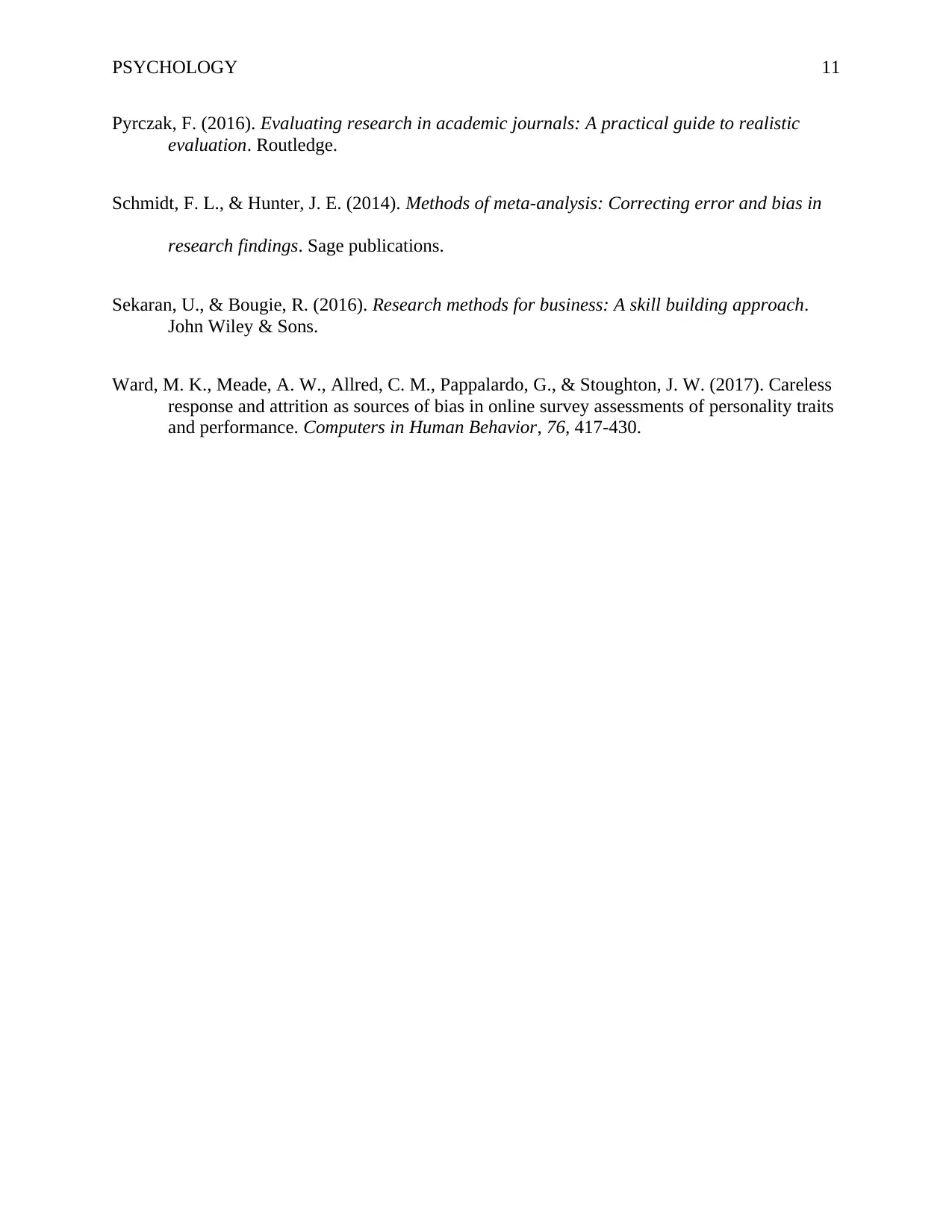
PSYCHOLOGY 11
Pyrczak, F. (2016). Evaluating research in academic journals: A practical guide to realistic
evaluation. Routledge.
Schmidt, F. L., & Hunter, J. E. (2014). Methods of meta-analysis: Correcting error and bias in
research findings. Sage publications.
Sekaran, U., & Bougie, R. (2016). Research methods for business: A skill building approach.
John Wiley & Sons.
Ward, M. K., Meade, A. W., Allred, C. M., Pappalardo, G., & Stoughton, J. W. (2017). Careless
response and attrition as sources of bias in online survey assessments of personality traits
and performance. Computers in Human Behavior, 76, 417-430.
Pyrczak, F. (2016). Evaluating research in academic journals: A practical guide to realistic
evaluation. Routledge.
Schmidt, F. L., & Hunter, J. E. (2014). Methods of meta-analysis: Correcting error and bias in
research findings. Sage publications.
Sekaran, U., & Bougie, R. (2016). Research methods for business: A skill building approach.
John Wiley & Sons.
Ward, M. K., Meade, A. W., Allred, C. M., Pappalardo, G., & Stoughton, J. W. (2017). Careless
response and attrition as sources of bias in online survey assessments of personality traits
and performance. Computers in Human Behavior, 76, 417-430.
1 out of 11
Your All-in-One AI-Powered Toolkit for Academic Success.
+13062052269
info@desklib.com
Available 24*7 on WhatsApp / Email
![[object Object]](/_next/static/media/star-bottom.7253800d.svg)
Unlock your academic potential
Copyright © 2020–2025 A2Z Services. All Rights Reserved. Developed and managed by ZUCOL.